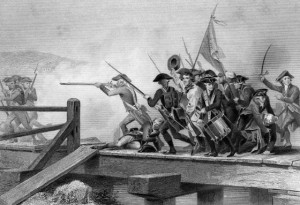Each April here at the American Antiquarian Society, our thoughts turn to Patriots’ Day, a holiday which we celebrated last week here in Massachusetts. Patriots’ Day commemorates the famous battles of Lexington and Concord, the battles that started the American Revolution. We 
You may have visited Paul Revere’s house in Boston’s North End or seen battle re-enactments in Lexington and Concord. You might know that Paul Revere was a member of the Sons of Liberty and that he had sixteen children and at least fifty-two grandchildren. You might not have known, however, that Paul Revere played many key parts leading up to the American Revolution, aside from the one Longfellow casts him in, the sounder of the Lexington Alarm. Before 1775, Paul Revere made many rides conveying messages from the Whigs in Boston to other patriots at greater distance. He rode to New York and Philadelphia to garner Whig resistance to The Intolerable Acts, a set of British laws colonists viewed as unfair. Since Revere knew many different people and moved in many different circles, he was an excellent messenger for Whig purposes. He took a leading part in getting the Stamp Act repealed. He participated in the Boston Tea Party, dumping teas chests into Boston Harbor. Revere also led a secret group of Whigs who  met in the Green Dragon Tavern in Boston. He sounded an Alarm in Portsmouth, New Hampshire to warn colonists of imminent British seizure of Whig munitions. He also influenced Whig sentiment by engraving the famous print, The Boston Massacre [pictured at right], which helped to depict the British as unjust in the eyes of the colonists.
met in the Green Dragon Tavern in Boston. He sounded an Alarm in Portsmouth, New Hampshire to warn colonists of imminent British seizure of Whig munitions. He also influenced Whig sentiment by engraving the famous print, The Boston Massacre [pictured at right], which helped to depict the British as unjust in the eyes of the colonists.
When the British Governor Thomas Gage decided to attack the town of Concord, seize its munitions, and attempt to capture John Hancock and Sam Adams (who were staying five miles to the east in the town of Lexington), the person selected to warn Concord was none other than Paul Revere. The Whig colonists resolved not to act first, to create an image of innocence, and therefore needed to mobilize quickly when the British made a move. Historian David Fischer noted, “Everything for New England depended on careful preparation, timely warning, and rapid mobilization” (79). Revere was clearly the man for the job since he could spread news throughout New England faster than Gage’s infantry could march.
In case the British cut off communication between Boston and outlying towns, Boston Whigs appointed messengers to slip past Gage’s men by secret routes and devised a system of lantern signals from Boston to Charlestown to alert the colonists to the Tories’ movements. Revere got wind of British movement from a stable boy and passed the news on to Doctor Joseph Warren. Warren verified the information with his Tory informant who was reputed to be Governor Gage’s American wife!
Revere enlisted two friends to put two lanterns in the Old North Church steeple, Boston’s tallest building in 1775, to warn Whigs that the British were coming by sea. The Old North Church was officially named Christ Church at the time and its rector was a Loyalist. Luckily Revere was friends with a vestryman, John Pulling, and a sexton, Robert Newman. These two men climbed into the rafters of the Old North Church and hung the famed two lanterns while their friend, Thomas Bernard, stood guard.
As Revere set out across the Charles River en route to Concord, another rider, William Dawes, a Boston tanner, was already on the road to Concord ahead of him. Two more little more known patriots, Joshua Bentley, a boat builder, and Thomas Richardson helped Revere cross the Charles River. Upon landing, Revere borrowed a horse from John Larkin named Brown Beauty, known for its strength and swiftness. Revere went north across Charlestown Neck and west on the road to Lexington.
When Revere arrived at the house where Hancock and Adams were staying, he shouted, “The Regulars are coming out!” Notably, he did not say, “The British are coming!” since all colonists in revolutionary America considered themselves British. William Dawes arrived a half hour later.
Revere and Dawes next headed to Concord. Along the way, they met Doctor Samuel Prescott, a physician of Concord who joined them in warning the colonists. The three men eventually encountered ten British Regulars on Concord Road. The British soldiers quickly surrounded Paul Revere and took his horse. Dawes escaped and went limping back to Lexington. Doctor Prescott was the only rider of the original three who made it past the British to sound the Alarm at Concord. Along the way, Prescott alerted many more Whig citizens who joined the Alarm. Revere regained his freedom at three o’clock in the morning on April 19th in time to see some of the battle on Lexington Green.
More information about Paul Revere’s ride and the battles of Lexington and Concord can be found in the books in the collections at the American Antiquarian Society. So this month, we invite you to explore the many stories behind history and to learn more about Paul Revere, the brave silversmith who helped craft our country’s past.
For Further Reading:
Fischer, David Hackett. Paul Revere’s Ride. New York: Oxford University Press, 1994.
Morgan, Edmund S., ed. Paul Revere’s Three Accounts of His Famous Ride. Boston: Massachusetts Historical Society, 2000.


Thanks for posting that correction or revision of the Longfellow version that has become stuck in the American mind, omitting all of the riders not only to Concord but to other communities. There were so many others — the late 18th-century version of “social networking,” unifying and informing Patriots. Not just Revere.